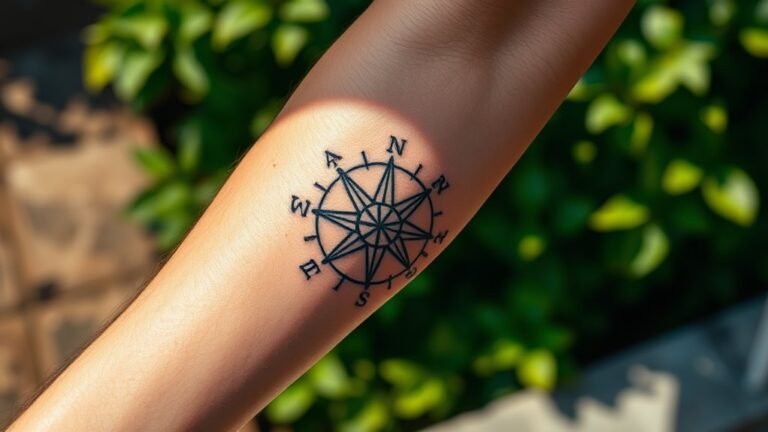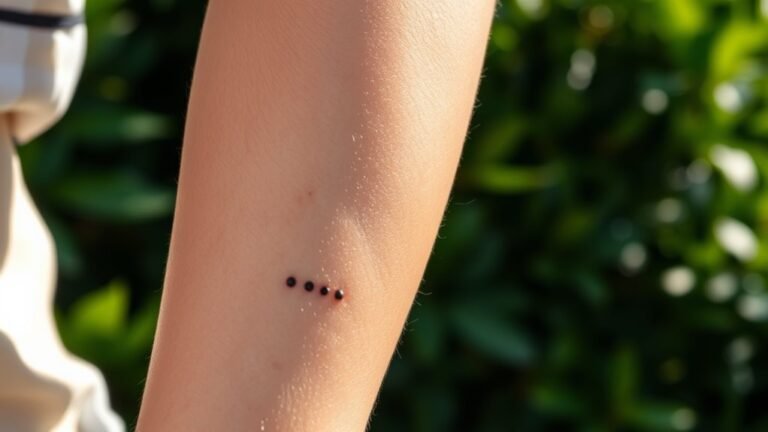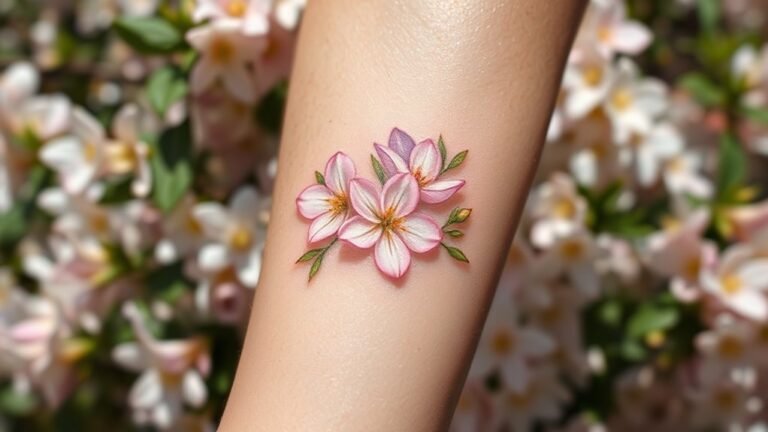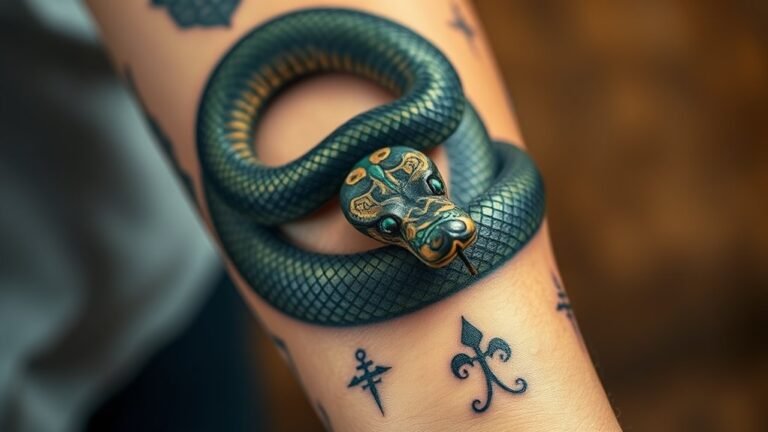The Llorona Tattoo Meaning and Symbolism
You might find the Llorona tattoo intriguing, as it captures deep emotional narratives rooted in folklore. This tattoo doesn't just showcase artistry; it embodies grief, loss, and cultural identity. As you explore its symbolism, consider how personal stories and societal struggles intertwine in these designs. What does it mean for individuals to wear such a poignant symbol on their skin? The answers reveal much about contemporary expressions of heritage and trauma.
In a Nutshell
- La Llorona tattoos symbolize grief, loss, and emotional turmoil, reflecting the pain of separation and abandonment.
- They serve as tributes to maternal figures, honoring their sacrifices and resilience in the face of adversity.
- The designs often incorporate elements like flowing hair, rivers, or children, emphasizing themes of longing and sorrow.
- Tattoos evoke cultural identity, connecting wearers to shared heritage and narratives surrounding La Llorona.
- Artistic interpretations transform personal trauma into expressions of strength, vulnerability, and communal mourning.
The Origins of La Llorona in Folklore
La Llorona, often translated as "The Weeping Woman," emerges from a rich tapestry of folklore that spans centuries and cultures, particularly in Latin America.
In Mexican folklore, she's one of the most haunting ghostly figures, symbolizing the struggles and fears of mothers. You might hear her story whispered in hushed tones, often told to children as a cautionary tale.
Her origins are rooted in themes of love, betrayal, and tragedy, reflecting societal values and fears surrounding motherhood and loss. Each retelling varies, yet they all evoke a shared sense of identity and belonging among communities.
Symbolism of Grief and Loss
The story of La Llorona resonates deeply with the symbolism of grief and loss, capturing the profound emotional turmoil experienced by those who've faced separation from loved ones.
This tale serves as a powerful grief expression, illustrating the haunting nature of sorrow that can linger long after a loved one is gone. Through her weeping, La Llorona embodies the loss representation that many individuals relate to, reflecting the pain of abandonment and heartache.
By embracing this symbolism in tattoos, you connect with a communal experience of mourning, finding solace in shared narratives of loss.
These tattoos not only honor personal tragedies but also foster belonging within a broader cultural context, allowing you to navigate your own grief journey alongside others.
Cultural Significance in Latin America
While many tales of folklore exist, few resonate as powerfully within Latin American culture as that of La Llorona. This haunting figure embodies deep cultural representations of grief, motherhood, and loss, reflecting the collective experiences of communities.
You'll find La Llorona woven into traditional narratives, serving as a cautionary tale that resonates in family storytelling. Her story often highlights the struggles faced by women, giving voice to their pain and resilience.
As you explore her significance, you'll discover how she transcends mere legend, becoming a symbol of cultural identity and shared history. Engaging with La Llorona allows you to connect with the emotional landscape of Latin American heritage, fostering a sense of belonging in a rich tapestry of cultural memory.
Artistic Interpretations of La Llorona Tattoos
Exploring the artistic interpretations of La Llorona tattoos reveals how this iconic figure has inspired a variety of designs that resonate with individual experiences and cultural narratives.
Many artists draw upon mythological influences, depicting La Llorona with flowing hair and haunting expressions that evoke her tragic story. Visual styles vary widely, from intricate line work to vibrant colors, reflecting personal interpretations and regional aesthetics.
Some designs incorporate elements like rivers or children, emphasizing themes of loss and longing. Each tattoo becomes a canvas for storytelling, inviting the wearer to connect with their heritage while expressing their emotions.
In this way, La Llorona tattoos not only honor tradition but also foster a sense of belonging within a community that shares these deep-rooted myths.
Personal Stories and Meanings Behind the Ink
When you choose a La Llorona tattoo, it often reflects a deeply personal narrative intertwined with cultural heritage. Each inked story carries emotional weight, connecting you to past experiences and familial ties.
Your tattoo journey may symbolize:
- Loss or grief, echoing the legend of La Llorona.
- A tribute to maternal figures, celebrating their sacrifices.
- A connection to cultural identity, embracing folklore.
- Healing from trauma, transforming pain into art.
- A reminder of the strength found in vulnerability.
These personal experiences shape your unique interpretation, fostering a sense of belonging within a larger community.
The Role of La Llorona in Modern Tattoo Culture
As the haunting tale of La Llorona resonates through generations, her image has become a powerful symbol in modern tattoo culture.
You'll find her depicted in various styles, reflecting diverse interpretations that connect deeply with personal narratives. This symbol transcends mere aesthetics; it embodies collective fears, cultural heritage, and the complexities of motherhood.
In today's tattoo trends, La Llorona serves as a vehicle for modern expressions of identity and resilience. By embracing her story, you're not just getting ink; you're participating in a rich tapestry of shared experiences.
This connection fosters a sense of belonging, uniting individuals who resonate with the themes of loss and redemption that La Llorona represents, making her a timeless figure in contemporary body art.
Frequently Asked Questions
Are There Specific Colors Associated With La Llorona Tattoos?
When exploring tattoo styles, you'll notice color symbolism plays an essential role. Deep blues and blacks often evoke mystery, while vibrant reds can symbolize passion. Each choice reflects personal narratives and cultural connections, enhancing your tattoo's meaning.
Can La Llorona Tattoos Represent Protection Instead of Grief?
Yes, La Llorona tattoos can symbolize protection rather than grief. By incorporating protective imagery, you embrace the duality of her story, transforming her sorrow into a shield that connects you to a deeper cultural narrative.
What Are Common Placements for La Llorona Tattoos on the Body?
When considering placements for La Llorona tattoos, you'll often find wrist designs for subtlety and intimacy, while back pieces offer larger canvases, allowing intricate storytelling and deeper connections to personal and cultural narratives.
How Do Different Artists Interpret La Llorona in Their Designs?
Different artists interpret La Llorona through unique styles and design elements, each reflecting cultural narratives. You'll find elements like flowing hair or tears, showcasing personal connections and stories that resonate deeply within the community.
Are There Variations of La Llorona in Other Cultures?
You'll find that cultural interpretations of La Llorona vary widely. Exploring folklore variations reveals unique narratives and symbols, highlighting how different communities express shared fears and values, fostering a sense of belonging through these haunting tales.







